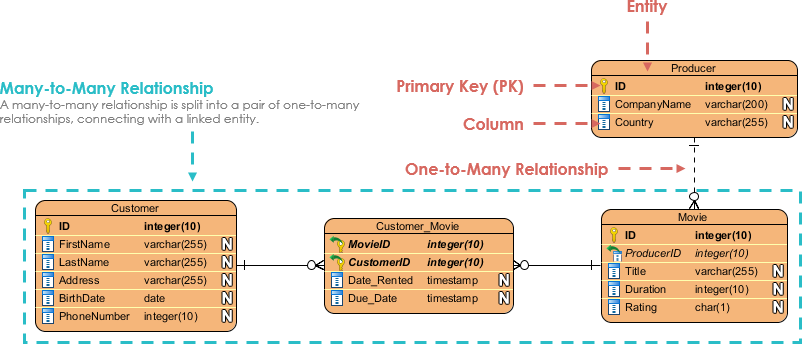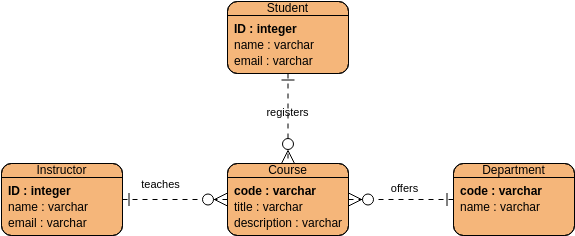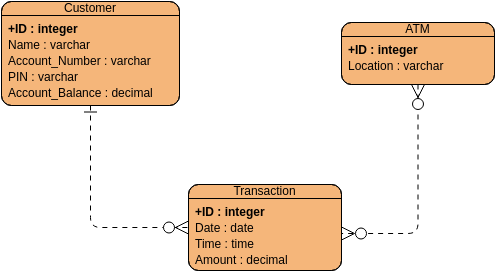Comprehensive Guide to Entity-Relationship (ER) Modeling: With Example
Introduction
Entity-Relationship (ER) modeling is a powerful tool for designing and representing complex data systems. This modeling technique allows developers to visualize the relationships between different entities in a system and the attributes associated with them. ER modeling is widely used in software engineering, database design, and information system management. In this article, we will provide a comprehensive overview of ER modeling, including its components, rules, and best practices. We will also provide an example of ER modeling using PlantUML.
ER Modeling Components:
ER modeling comprises three primary components: entities, attributes, and relationships. An entity represents a real-world object or concept, such as a customer, order, or product. Each entity has attributes, which describe the characteristics of the entity. For example, a customer entity may have attributes like first Name, Last Name, Address, phone number, and etc.
A relationship represents the association between two or more entities. For instance, a customer may place an order for one or more products, or a product may belong to a specific category. Relationships can be one-to-one, one-to-many, or many-to-many. The cardinality of a relationship specifies the number of entities that can participate in the relationship.

Advantages of ER Modeling
ER modeling is a widely used technique for designing data systems, and it provides many benefits over other approaches. In this section, we will explore some of the key advantages of ER modeling, including its ability to promote clarity, flexibility, efficiency, consistency, collaboration, scalability, and maintenance.
Here are some advantages of using ER modeling:
- Clarity: ER modeling provides a clear and concise representation of a data system, making it easier for developers and stakeholders to understand and communicate about the data.
- Flexibility: ER modeling allows developers to modify and adjust the data system as needed, by adding or removing entities, attributes, or relationships.
- Efficiency: ER modeling enables developers to optimize the data system for efficiency and performance, by eliminating redundant data and organizing it in a logical and structured manner.
- Consistency: ER modeling promotes consistency and accuracy in the data system, by enforcing a set of rules and best practices that ensure the data is well-organized and error-free.
- Collaboration: ER modeling fosters collaboration between developers, stakeholders, and end-users, by providing a common language and framework for discussing and designing the data system.
- Scalability: ER modeling supports the scalability of the data system, by enabling developers to add new entities and relationships as the data system grows and evolves over time.
- Maintenance: ER modeling simplifies the maintenance of the data system, by providing a clear and structured representation of the data that makes it easier to troubleshoot and fix issues.
ER Modeling Rules:
ER modeling follows a set of rules to ensure consistency and accuracy in the design. The rules are as follows:
- Entities must have unique names and attributes.
- Relationships must have unique names and cardinalities.
- Relationships must be connected to at least two entities.
- Attributes must be atomic, i.e., they cannot be further divided into smaller components.
- Relationships cannot have attributes.
- Attributes cannot be associated with relationships.
- Relationships cannot connect an entity to itself.
- Cardinalities must be specified for all relationships.
ER Modeling Best Practices:
To create effective ER models, developers should follow best practices, including the following:
- Start by identifying entities and their attributes.
- Determine the relationships between the entities.
- Specify the cardinalities of the relationships.
- Normalize the data to remove redundant data.
- Use consistent naming conventions for entities, attributes, and relationships.
- Validate the ER model with stakeholders to ensure accuracy and completeness.
Example of ER Modeling – Example Student Registration:
To illustrate ER modeling, let’s consider an example of a university course registration system. The system has the following entities: student, course, instructor, and department. The relationships between these entities are as follows:
- A student can register for one or more courses.
- A course can be taken by one or more students.
- A course is taught by one instructor.
- An instructor can teach one or more courses.
- A department can offer one or more courses.
- A course belongs to one department.
Based on these relationships, we can create the following ER model

ERD Example – Book Database
Suppose we are creating a database to store information about books and their authors. The database needs to track details such as the author’s name, email address, and biography, as well as the book’s title, publication date, and genre. In addition, we want to track which authors have written which books, and which books have been purchased by which customers.
Here’s the ERD:

ERD Example – ATM System
Suppose we are designing a database for an automated teller machine (ATM) system. The database needs to track details such as the customer’s name, account number, PIN, and account balance. In addition, we want to track the location of the ATM machines and which transactions have been performed at each machine.

Summary
In this article, we explored the concept of ER modeling, which is a technique used to design and represent complex data structures. We discussed the advantages of using ER modeling, including its ability to simplify complex data structures, make data relationships more clear, and facilitate communication between stakeholders.
To illustrate the concept, we provided examples of ER diagrams using the PlantUML tool, including an ERD for a bookstore and an ERD for an ATM system. We also generated a problem description for a college student course registration system and created an ERD, we then give you some more ERD examples.
Overall, ER modeling is a useful tool for designers and stakeholders to understand complex data structures and their relationships. By representing these structures visually, ER modeling can help streamline communication and ensure that all parties are on the same page when it comes to understanding the underlying data architecture.


